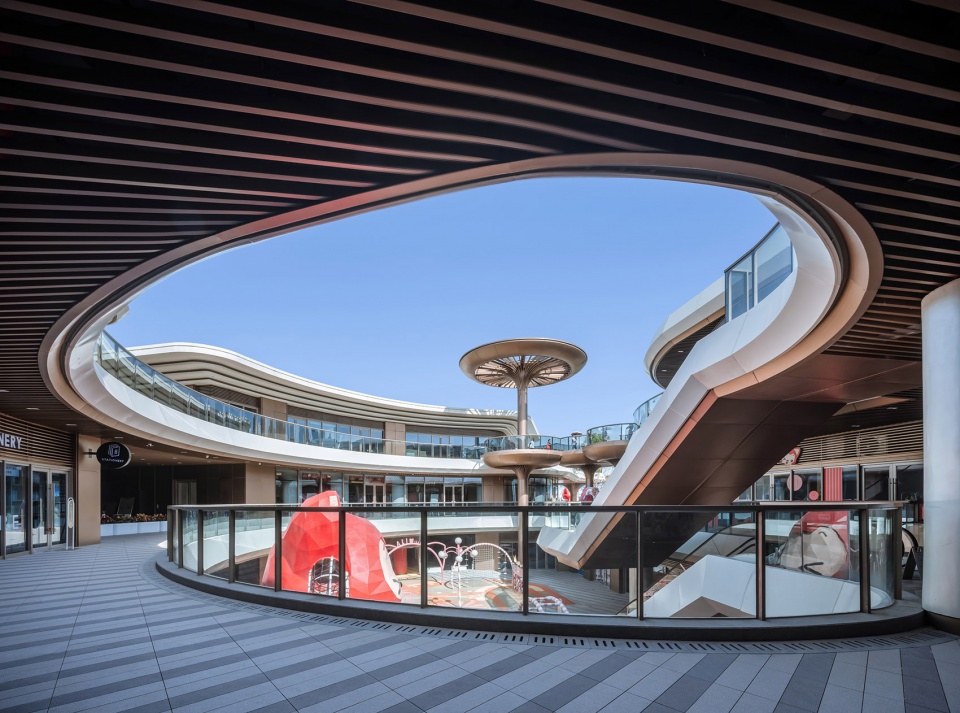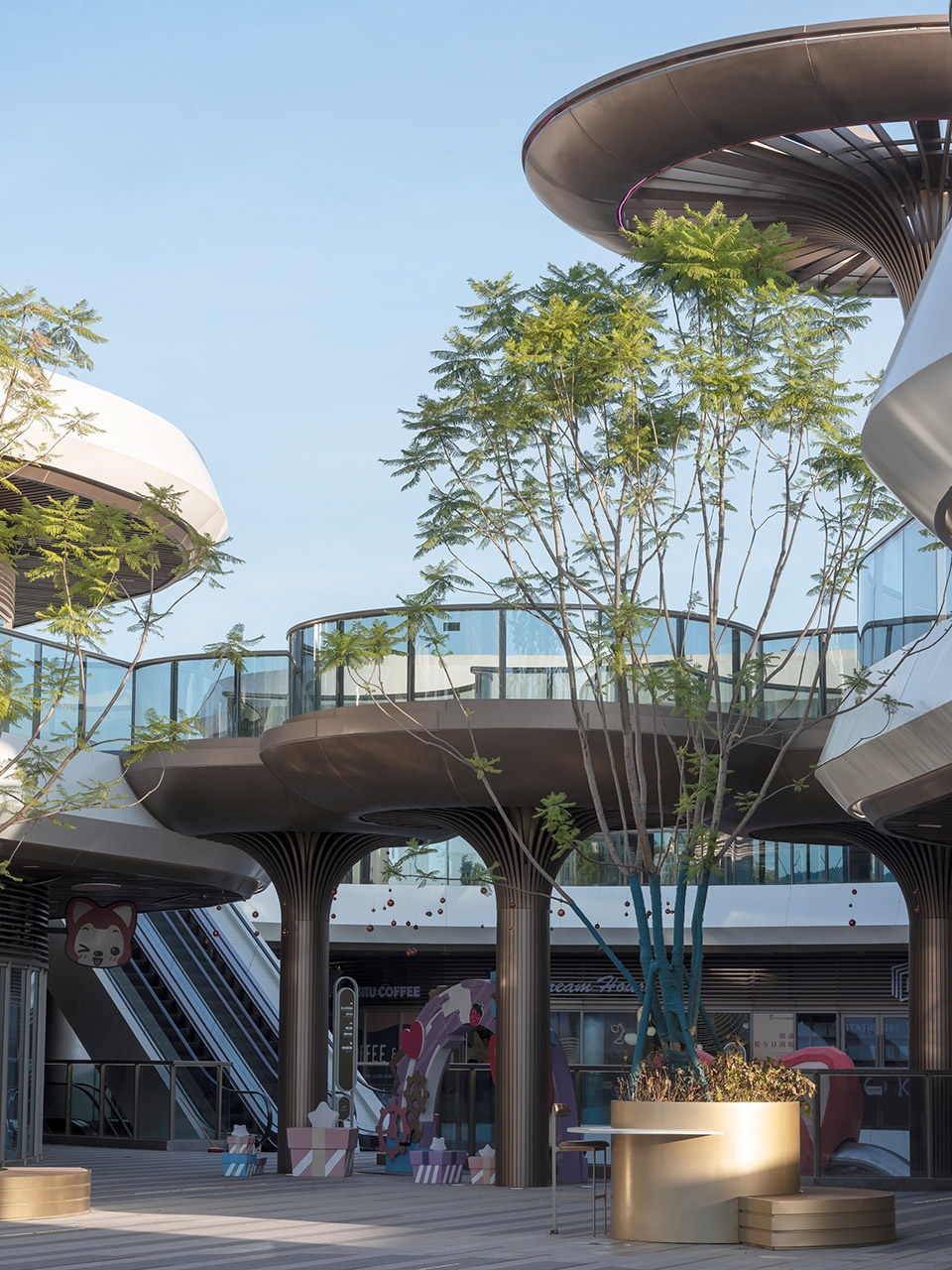

前言 – 我们需要什么样的建筑(场地与建筑)
Preface – What kind of architecture we need (site and architecture)
项目位于重庆市蔡家自贸区,属主城卫星带,近2000亩公园配套,以及自贸区城市战略支撑,区域属于重庆北高端生态宜居聚落。基地附近同期建设居住区以满足大量市区外溢人口的入驻需求,业主需要在这里去配建社区商业去满足附近人群的功能使用需求。
The project is situated in the Caijia Free Trade Zone in Chongqing, which is a satellite belt of the main city. Covering an area of nearly 2,000 mu, the zone is supported by a park and benefits from the city’s Free Trade Zone strategy. As such, it belongs to Chongqing’s high-end ecological and livable colony in the north. The residential area near the base was built simultaneously to accommodate the influx of people from the urban areas. The owners of the residential area need to establish community businesses to cater to the functional needs of nearby residents.
▼项目概览,overall of the project © 胡义杰


解析 – 建筑与社会心理的影响与反馈
Analysis – The influence and feedback of architecture and social psychology
欧洲大流感后所产生的极简主义,反映出当时人们讲卫生的心理倾向。柯布的萨伏伊别墅精炼出的建筑五要素则满足人们对于未来居所阳光,卫生的想象。建筑形态既受到当代社会集体文化心理情结的影响,又构建了新的集体文化心理情结的重要形态。
he emergence of minimalism in Europe after the pandemic reflected people’s psychological need for hygiene at that time. The five refined elements of architecture by the Villa Savoy in Cobb fulfilled people’s imagination of a future residence that is bright and hygienic. This architectural form is not only influenced by the collective cultural psychological complex of contemporary society but also constructs an important form of the new collective cultural psychological complex. The architectural form is not only influenced by the collective cultural psychological complex of contemporary society but also plays a crucial role in shaping a new form of the collective cultural psychological complex.
▼以云为灵感的商业园区造型,the design of commercial park is inspired by the could © 胡义杰

▼丰富多元的商业场景,rich and diverse commercial space © 胡义杰

一个理想的公共场所应能满足持续变化的,日常中的基本需求,在人们不断的使用后逐渐形成某种集体文化,新集体文化心理情结进一步改变了过去对于场所的定义和建筑的形态,并带来人们对未来生活新的想象。
An ideal public place should be able to cater to the evolving basic needs of daily life and, over time, foster the development of a collective culture among its users. This new collective cultural complex contributes to a redefinition of place and the architectural form, thereby influencing people’s imagination of future life.
▼底层商铺,stores on the ground floor © 胡义杰

▼商铺外观,external view of the building © 胡义杰

社区商业发展至今,单调普通的商业形态已无法承载Z世代这一新集体文化心理情结,Z世代消费理念的多元特质,倒逼社区商业更加复合多样性,独特创新,实现区别于互联网的沉浸式线下社交体验。
The current state of community business development reveals that the conventional and monotonous business forms are no longer capable of accommodating the new collective cultural complex of Generation Z. The diverse consumption preferences of Generation Z demand that community businesses become more innovative, unique, and multifaceted, and provide an immersive offline social experience that is distinct from that of the Internet.
▼伞状构筑下方的公共空间,public space below the umbrella structure © 胡义杰

▼底层空间近景,closer view of the ground floor © 胡义杰

新的社区商业形态除了满足人们在社区内体验到娱乐、消费、养老、商务等基本便利,更重要的是通过想象赋予社区新的集体文化,以社区场所营建,业态设计,主题设计等为主要手段,通过空间为载体来展现社区独属文化,滋养延续场所精神。
Apart from catering to the community’s basic needs for entertainment, consumption, retirement, and business, the new community business form has a more significant role to play in fostering a new collective culture within the community through imaginative means. Community place construction, business design, and theme design serve as crucial tools to showcase the unique culture of the community by utilizing space as a carrier, and to nourish and sustain the spirit of the place.
▼二层空间,the upper floor space © 胡义杰

概念 – 阿狸飞过留下的空间与场所
Concept – The space and place left by the Ali flying over
当我们接到委托去设计这样一个项目的时候,我们发现人口新聚集于这个公共场所,通过地域或者某种特别的联系融合在一起,人与人之间的运动轨迹就如云般在流动。相遇、相离,产生无数可能的链接。建筑作为表达和沟通的媒介,以富有创意的主题空间的营造,通过满足亲密,社会,陌生等不同尺度的场景,建立出积极互动的过程。
When we were tasked with designing such a project, we observed that the population was relatively new to this public place, and came together through the shared territory or some special connection. The movement trajectory of people within the space resembled a flowing cloud. The constant meeting and parting of individuals within the space gave rise to countless potential connections. Architecture as a medium of expression and communication, with the creative creation of thematic spaces, establishes a process of positive interaction by meeting scenarios of different scales of intimacy, sociality, and strangeness.
▼商业区中的儿童活动空间,children’s activity space in the business district © 胡义杰


我们以云为灵感的造型让整个商业外部视觉既具整体性又富有变化,最大限度的发挥了沿街展示面的昭示性,为垂直密集的城市和主干道之间提供了视线和空间的缓冲。富有创意的空间造型,在满足商业价值的同时,充分扩展公共空间的可能性,全方位激发城市公共空间的活力,并对人们的生活方式带来潜移默化的积极影响,让项目成为城市空间成长的一部分。
Our cloud-inspired form allows for both integrity and variation in the overall commercial exterior vision, maximizing the indicative nature of the display surfaces along the street and providing a buffer of sight and space between the vertical density of the city and the main road. The innovative spatial design not only meets commercial needs but also expands the potential of public space, invigorating urban public spaces in various ways and subtly influencing people’s lifestyles. By contributing to the growth of urban space, this project has a positive impact on the community.
▼阿狸飞过留下的空间与场所,The space and place left by the Ali flying over © 胡义杰

在地性 – 形式转译与空间趣味性
Locality-translation of forms and spatial interest
商业习惯源于集体生活的状态和文化的延续,是集体记忆的一种行为表现。千百年来,重庆人们历史生活留下的印迹与当代人们对于未来生活的想象在新的城市商业空间中碰撞融合,映射着商业模式的延续与变化。新主题商业空间的广场、阶梯、连廊、商铺的场景设计都为人们游逛商业提供了沉浸式的消费体验,为项目提供了更丰富多元的商业想象。
Commercial habits are rooted in the collective experiences and cultural traditions of a community, and serve as a behavioral manifestation of its collective memory. Over the course of thousands of years, the historical legacy of the people of Chongqing and their present-day aspirations for the future converge and blend within the new urban commercial space, showcasing the evolution and transformation of business models. The design of the square, stairs, corridors, and shops in the new themed commercial space creates an immersive consumer experience that encourages people to explore and peruse the businesses. This design approach fosters a more diverse and imaginative business environment for the project.
▼夜景,night view © 胡义杰

设计师在研究了重庆城市空间模型与行为模式之间的对应关系后,将当地居民于日常购物的基本行为:登,逛,望,游的空间特征加以概括提取,并巧妙地运用到现代商业节点的空间场景的设计,建立场地与人们之间的集体记忆。
After analyzing the correlation between the spatial model and behavior patterns of Chongqing city, the designer identified the spatial characteristics of the fundamental behavior of local residents during daily shopping, including climbing, strolling, looking, and swimming. These characteristics were expertly integrated into the design of modern commercial nodes’ spatial scenes, establishing a collective memory between the site and its visitors.
▼前后错落的伞状又呼应山城立体交互的空间特征,the umbrella-shaped staggered front and back design reflects the spatial characteristics of the three-dimensional interaction of the mountain city © 胡义杰

项目入口处的伞状构筑,通过简明的主题形状,加强人们的视觉体验,更快建立属于该场所的集体记忆,同时抽象的构筑形式又给人们形成模糊的想象。即使是理性的成年人也可以拥有的浪漫想象,集体记忆进一步加强。前后错落的伞状又呼应山城立体交互的空间特征,与人们熟悉的空间体验进一步呼应。
The umbrella-shaped structure at the entrance of the project strengthens people’s visual experience and establishes the collective memory of the site more quickly through the concise shape of the theme, while the abstract form of the structure gives people a vague imagination. Even rational adults can possess a romantic imagination, which serves to further reinforce collective memory. The umbrella-shaped staggered front and back design reflects the spatial characteristics of the three-dimensional interaction of the mountain city, thus evoking a familiar spatial experience for people.
▼项目入口处的伞状构筑,the umbrella-shaped structure at the entrance © 胡义杰

抬头是如云般舒展的空间曲线,将空间望更深处引导。步移景异,空间的焦点轮换到汀步云台,区别于传统的直线或者曲线连廊,设计师以圆台为设计要素,高低错落的圆台像自然生长于野外的蘑菇,似高高低低的云,又似童年时期的超级玛丽,充满童趣,和谐自然。
The upward curve of the spatial design resembles a cloud, creating a sense of depth and leading the viewer’s gaze further into the space. In contrast to traditional linear or curved corridors, the designer incorporates round platforms as a unique design element. The high and low platforms resemble mushrooms growing naturally in the wild and clouds of varying heights, evoking a sense of childhood nostalgia and playfulness. The resulting design is harmonious and natural.
▼廊桥与圆台,bridge and round platforms © 胡义杰

穿过云桥,阿狸主题的中心雕塑和四周曲线走廊的弱限定则暗示这是一个人们聚集玩乐的空间,既可以举办一些集体活动,同时也是Z时代打卡标记的点。主题张力辐射覆盖整个场域,隔出人群想象的空间,沉浸体验阿狸主题的梦幻与童趣
The cloud bridge, central sculpture featuring a Ali theme, and the curved corridor’s gentle boundaries all suggest that this space is intended for socializing and recreation. The area can accommodate collective activities and serves as a landmark of the Z era. The thematic tension permeates throughout the entire space, creating a clear separation for visitors to immerse themselves in the dreamy and playful world of the Ali theme, stimulating their imagination and sense of childlike wonder.
▼建筑外观细部,details of the building © 胡义杰


可持续 – 城市空间与社区经营的共同成长
Sustainable – Co-growth of urban space and community management
历史哲学家泰勒(charles taylor)研究指出,现代市民社会本身就是通过社会想象(social imagination)形成的。又如费孝通先生在《乡土中国》中所说:现代社会本质上是陌生人社会。多元社会的正常运转必然需要一些共享价值观念作为价值基础和支撑,以实现价值认同与聚合。基于陌生人之间零散、随机的公共链接很难形成可持续的集体记忆,于是通过阿狸主题制定社区商业的共同的集体文化心理情结,形成新的社区文化。在地形的形式转译和空间塑造,延续根植于山城人们骨血里关于城市空间的身体记忆,以场所空间和文化内涵双管齐下,以黏合新旧场所精神的裂痕,促进城市空间与社区经营的共同成长。
Renowned philosopher Charles Taylor has argued that social imagination played a key role in the formation of modern civil society. In his book “China in the Countryside,” Fei Xiaotong observed that modern society is essentially a society of strangers. In order for a pluralistic society to function properly, it is necessary to establish shared values as a foundation for creating a sense of value identity and cohesion. As a result of the fragmented and sporadic public connections between strangers, it is challenging to establish a sustainable collective memory. To address this issue, a new community culture is being cultivated through the development of a shared collective cultural and psychological identity around the Ali theme in community businesses. Through topographical translation and spatial shaping, this project preserves the physical memory of the urban space that is deeply ingrained in the history and culture of the mountain city. It adopts a two-pronged approach that combines place space and cultural connotation to bridge the gap between the old and new place spirit. By doing so, it promotes the shared development of urban space and community businesses.
▼俯瞰园区,aerial view © 胡义杰

▼景观设计,landscape design © 胡义杰

▼总平面图,master plan ©AAI·里未设计

▼地下层平面图,basement floor plan ©AAI·里未设计

▼一层平面图,ground floor plan ©AAI·里未设计

▼二层平面图,upper floor plan ©AAI·里未设计

▼立面图,elevations ©AAI·里未设计


▼剖面图,sections ©AAI·里未设计


项目名称:重庆阿狸共享中心
项目类型:社区商业
设计方:AAI·里未设计
项目设计:2021年
完成年份:2023年
设计团队:罗启闻,包晋晋,骆铭树,吴黄琳,郑墨,林钰桢
项目地址:重庆市北碚区江家坪立交斜石偏组
建筑面积:7356㎡
摄影版权:胡义杰
合作方:景观设计:上海岱朴景观设计有限公司
客户:重庆卓麒房地产开发有限公司
材料:铝板
品牌:凤铭铝材












